|
|
| |
|
COLLECTING 007
US Magazines from the height of ‘Bondmania’
WRITTEN &
COMPILED BY KEVIN HARPER |
|
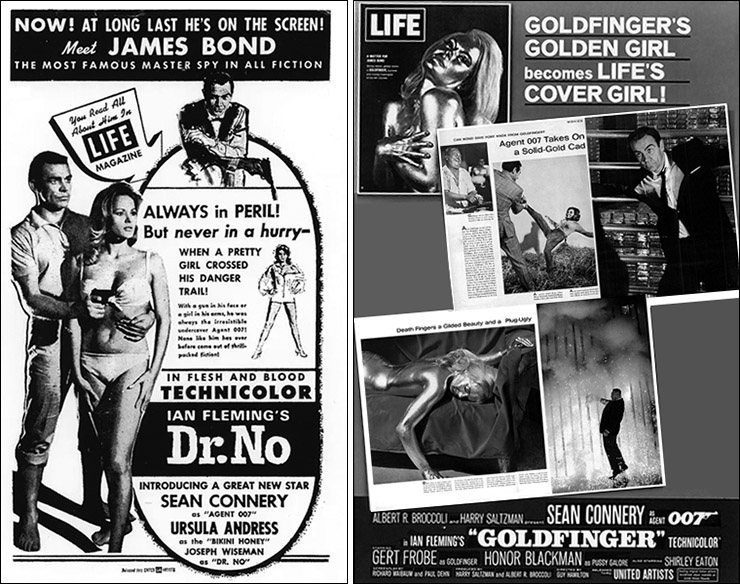 |
|
Following the
release of
Dr. No in the USA in 1963, the James Bond films went on to become
more successful with the debut of each successive title in the long-running
series. By late 1964 the James Bond films had become so ubiquitous, that
the series made its debut on the cover of LIFE - an American
magazine published weekly from 1883-1972. The wide-ranging
general-interest magazine was known for the quality of its photography,
and was one of the most popular publications in the nation, regularly
reaching one-quarter of the population of the United States. At the height
of ‘Bondmania’ in the mid-1960s both Goldfinger (1964) and Thunderball
(1965) appeared on the covers, and were previewed in several other magazines and
specialist publications when first released in the USA. The magazines
pictured on this page were all published in the USA (unless otherwise
stated), and although copies
would also be available internationally, their covers and contents could
be different. |
|
|
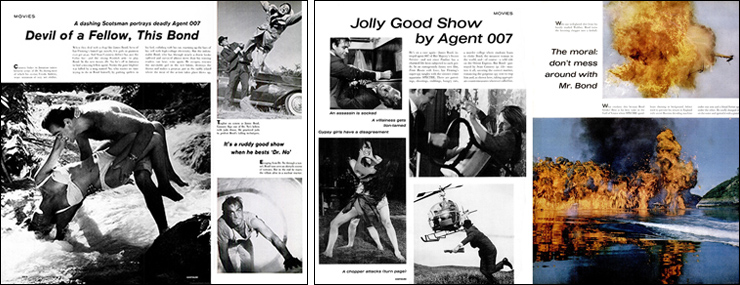 |
|
The first James Bond film
Dr. No (1962) was previewed in the May 24, 1963 edition of LIFE,
with Sean Connery then profiled in the April 3, 1964 edition to promote
the US release of From Russia With Love (1963), accompanied by
another two-page photo spread. |
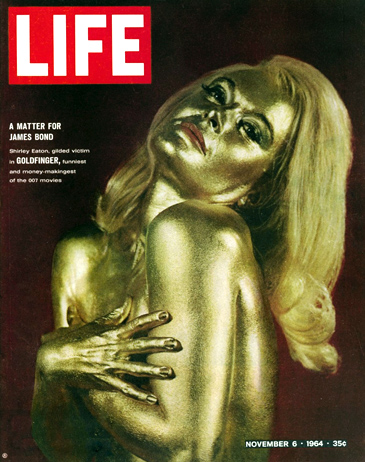 |
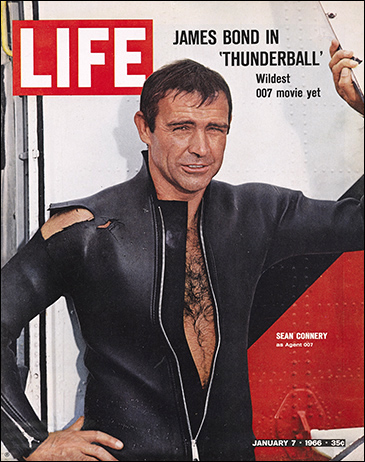 |
|
November 6, 1964 [ROLLOVER for
International Edition]
Shirley Eaton (1937- )
Photograph/Loomis Dean (1917-2005) |
January 7, 1966
Sean Connery (1930-2020)
Photograph/Loomis Dean |
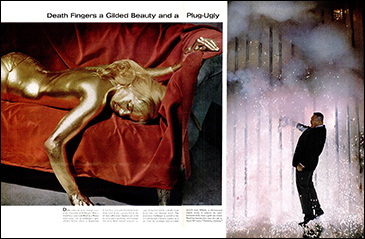 |
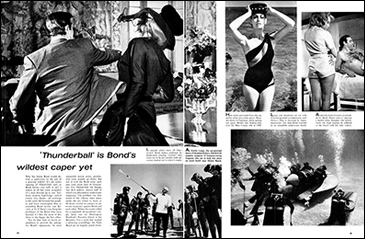 |
|
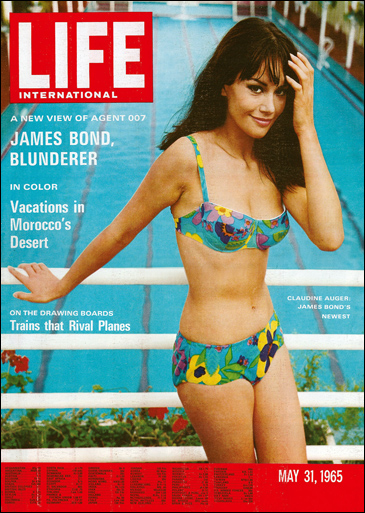 |
|
May 31, 1965
LIFE International
Claudine Auger (1941-2019)
Photograph/Peter Basch (1921-2004) |
|
The gold-painted image of
Shirley Eaton that made the cover of LIFE on November 6, 1964 sparked the
beginning of ‘Bondmania’ across the USA. A four-page preview of
Goldfinger appeared inside, including another colour photo of
Shirley Eaton by Loomis Dean. Sean Connery then made
the cover of the January 1966 issue of LIFE to tie in with the
release of Thunderball (1965). A three-page spread of
black & white photographs appeared inside.
Claudine Auger
(1941-2019) was featured on the cover of LIFE International on May
31, 1965, with a three-page feature on Thunderball (1965) then
filming in The Bahamas. The cover was by German-born photographer Peter Basch
(1921-2004), who captured Claudine Auger by a pool in Paris
following the press conference announcing her casting as Domino in
February 1965. Unusually this issue was not published in the USA, and the
feature did not appear in any other 1965 editions of the American version
of LIFE. The International edition was available in many other
countries including the British Isles, Europe and Japan, and also
available to the US Armed Forces stationed overseas.
James Bond author Ian Fleming was then
also the subject of a
special fold-out cover of LIFE on October 7, 1966, when the
first of a two-part serialization of
John Pearson's biography The Life
of Ian Fleming was published in the magazine. The image of Ian Fleming
behind the wheel of a supercharged 4½ litre Bentley was taken in 1962 by long-time LIFE
photographer Loomis Dean (1917-2005). |
|
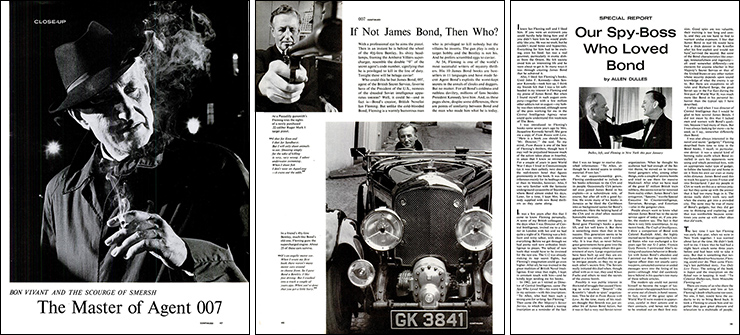 |
|
Other photographs taken of Ian Fleming
by Loomis Dean had appeared in the August 10, 1962 edition of
LIFE [pictured above left & centre] which featured a five-page
close-up of the James Bond author, although did not
make the front cover. Ironically, it was recently elected President John F.
Kennedy's endorsement of the James Bond novels in a 1961 LIFE
article that led to Ian Fleming's work becoming more popular in the USA.
In the March 17, 1961 issue Kennedy had listed his ten favourite books,
placing FROM RUSSIA, WITH LOVE at number nine, resulting in a
much-needed boost to the sales of the James Bond novels in the USA,
which up until this point had only sold in small numbers. The success
of the Sean Connery films consolidated the interest in all things 007,
and the novels eventually became best-sellers across the nation. Two
weeks after Ian Fleming's death, LIFE published a special
report in the August 28, 1964 edition [pictured above right], titled
‘Our Spy-Boss Who Loved Bond’, written by his friend and former CIA
director Allen Dulles (1893-1969). The appreciation was accompanied by
a photograph of Dulles and Fleming at their last meeting in January
1964. The article was later reprinted in the 1965 paperback anthology
For Bond Lovers Only edited by Sheldon Lane. |
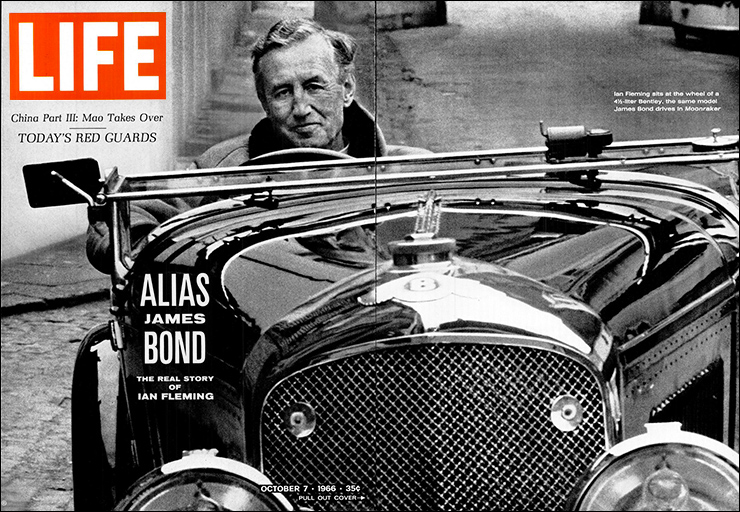 |
|
October 7, 1966
Ian Fleming (1908-1964)
Photograph/Loomis Dean [taken in 1962] |
|
|
In addition to the first
four films in the EON Productions series, the spoof version of Ian
Fleming's Casino Royale was also showcased in a three-page colour
picture spread in the April 21, 1967 edition of LIFE, featuring
photographs by Larry Shaw and
Terry O'Neill.
|
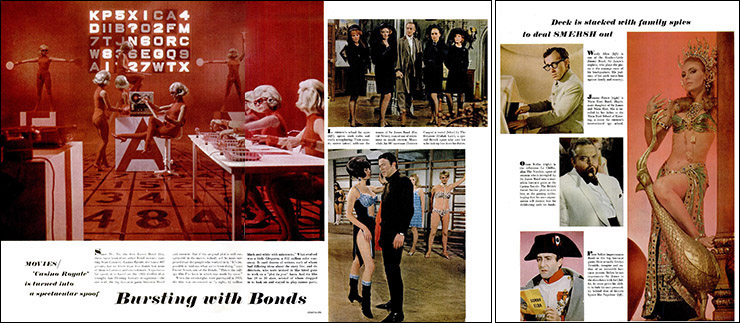 |
|
George Lazenby's casting
as the new James Bond featured in the October 11, 1968 edition of LIFE
accompanied by a special four-page feature with photographs by Loomis Dean of the
different actors testing for the
role. Once, again this feature did not make the cover of LIFE,
and many of the photographs from the session were not published until
2009, when LIFE made them available on their website to coincide with the
40th Anniversary of On Her Majesty's Secret Service (1969).
|
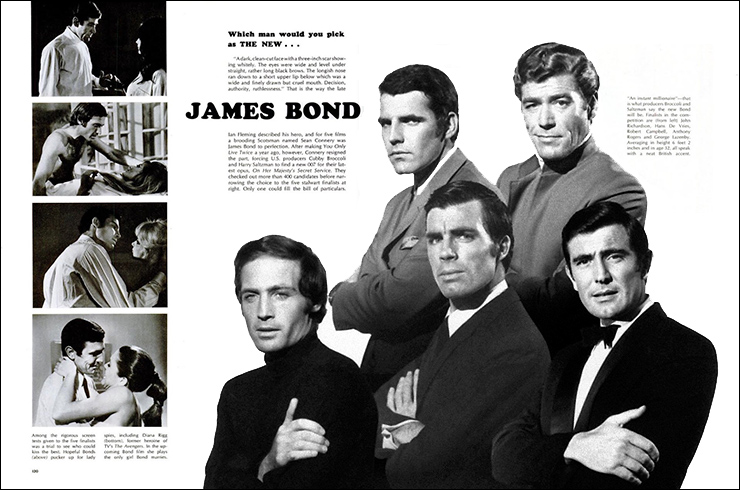 |
|
October 11, 1968
LIFE double-page spread
Photograph/Loomis Dean
Main picture: (top row) Hans De Vries and Anthony Rogers (bottom row)
John Richardson, Robert Campbell and George Lazenby. |
|
|
|
|
|
|
In 1960 Ian Fleming wrote
an article entitled ‘The Russians Make Mistakes, Too’, which was printed
in the November issue of the popular American men's magazine Esquire
(first published in 1933), as part of a larger feature with the
overall title ‘A Handbook For Professional Spies’. The piece was written
shortly after the United States lost their U-2 spy plane (flown by Gary
Powers) on May 1, 1960 after it was shot down by the Soviet Air Defence
Forces while conducting photographic aerial reconnaissance deep inside
Soviet territory. |
|
Ian Fleming was later
featured as part of a picture essay entitled ‘Tough Cookies’ in the
December 1961 issue of Esquire, as his novels were becoming more popular in the
USA. The iconic image of Ian Fleming with a revolver, photographed by Dan Wynn (1920-1995),
would later appear on the rear of the dust jacket for the
US New American Library first edition
of ON HER MAJESTY'S SECRET SERVICE in 1963. Esquire captioned the
photograph: ‘Ian Fleming, ex-foreign manager of London's Sunday Times,
delights in chronicling the capers of hard-fighting, woman-dazzling,
danger-loving secret agent James Bond. His readers, who find Mike Hammer a
boor, include professors, parsons, and the President of the United States’.
Esquire later played an important part in the ongoing promotion
of the film series in the USA. The June 1965 issue devoted its front cover
and 12 pages of content to Thunderball - almost six months ahead of
its release in New York. Distributor United Artists were extremely pleased
with the coverage given to the forthcoming James Bond film, which they
acknowledged as one of the best and biggest breaks ever given a motion
picture by the popular publication. |
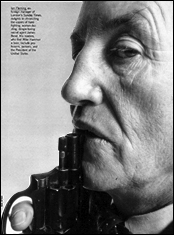 |
|
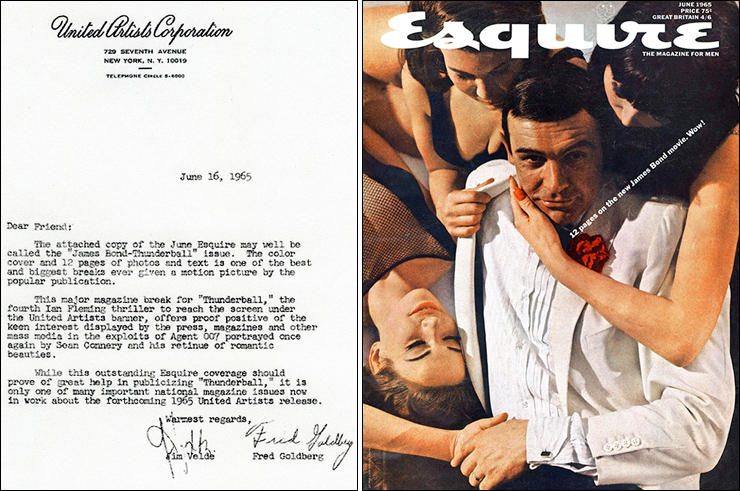 |
|
To cross-promote
Thunderball and the Esquire coverage, the National Screen Service issued a
poster (40" X 60") that was displayed in cinemas long before the
film was released. The black & white poster showed all 12 pages of the
Esquire feature, although much of the content in the magazine was
in colour. The article titled ‘Killing Off Bond’ showcased the girls and gadgets
of Thunderball, alongside production drawings by assistant art
director Michael White (1933- ), storyboards drawn by chief draughtsman
Peter Lamont, and sketches
by Production designer Ken Adam. |
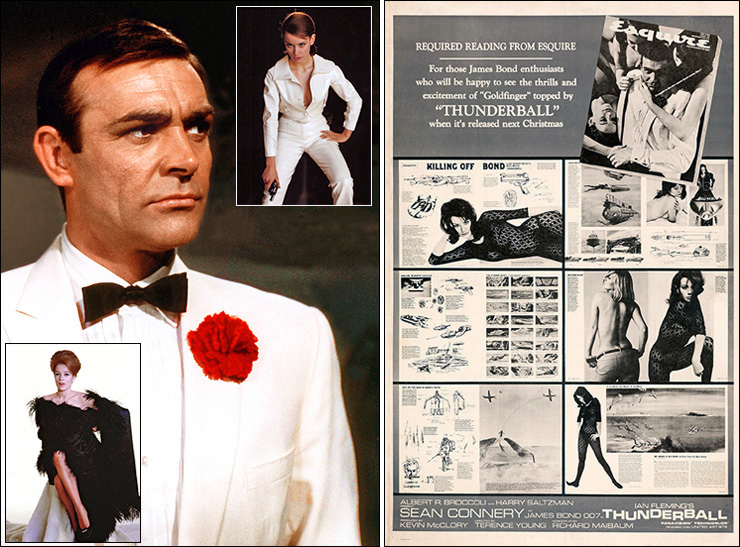 |
|
The Esquire cover
image of Sean Connery with three Bond Girls (Claudine Auger,
Molly Peters and
Mitsouko) was designed by George
Lois (1931-2022), and photographed by Timothy Galfas (1924-2013). The shots inside
of Claudine Auger, Luciana Paluzzi and Mitsouko were taken by renowned
Belgian-born photographer Robert Freson (1926-
). Seen on the cover (top
left) is the British actress and glamour model who played Nurse Patricia
Fearing in Thunderball, before her hair was bleached blonde for the
role. Several of the photographs from the Esquire session were used
in other publicity for the film. The image of Sean Connery
released from the Freson shoot, wearing a white tuxedo with a red
carnation is often misidentified by picture libraries and the media as
being from
Goldfinger, as Bond wears a white
dinner jacket and accompanying red carnation in the pre-credit sequence of
the 1964 film. The photograph (above left) taken by Freson for the
Esquire shoot clearly shows Sean Connery sporting his new-style
Thunderball hairpiece. One of Freson's stills of Sean Connery in
the white tuxedo appeared in the
1965 James Bond annual
and was correctly captioned as being from Thunderball. Also featured in Esquire's Thunderball
feature was a full-colour double-page illustration of the underwater
battle credited to Wright and Spencer. Also in this issue was an article
by screenwriter
Richard Maibaum titled ‘MY
WORD IS HIS BOND: A View from the Back Room’. Maibaum would also
contribute to the pictorial essay ‘James Bond's Girls’ to the
November 1965 issue of PLAYBOY. |
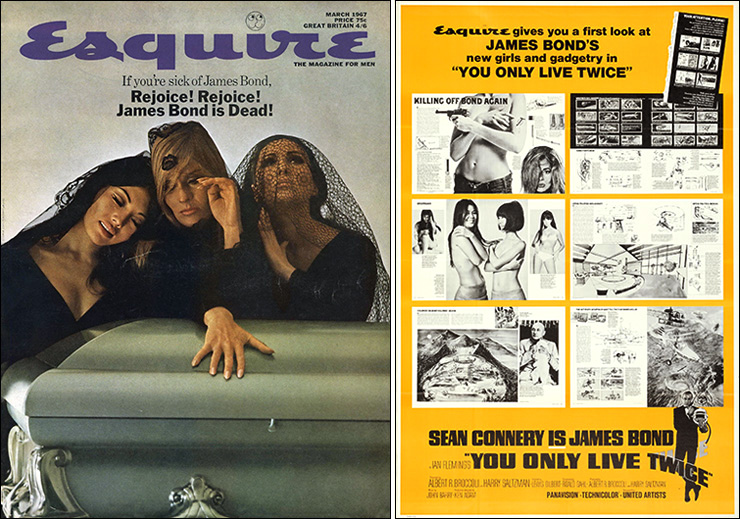 |
|
Twenty months after
Esquire had previewed Thunderball, a similar extensive article
was published in the March 1967 issue. This time titled ‘Killing Off Bond
Again’, Esquire announced that the new film
You Only Live Twice starts out with
James Bond getting killed. The provocative front cover showed three unidentified women
grieving over the coffin of James Bond was once again designed by George
Lois, and photographed by Timothy Galfas. The 12-page feature once again showcased
the girls, gadgets and set design of the latest James Bond film, with
photographs by Brian Duffy (1933-2010), pencil sketches by
Michael White,
and drawings by Robert Laing and
Ken Adam of the sets and ‘Little Nellie’
autogyro. The pre-credit opening sequence is presented as storyboards, and
eye-catching colour paintings by Roy Spencer are also showcased in the
magazine showing the Volcano interior and helicopter battle. Once again, a
special poster (40" X 60") was produced by the National Screen Service to be
displayed in cinemas ahead of the June 1967 release of You Only Live
Twice. |
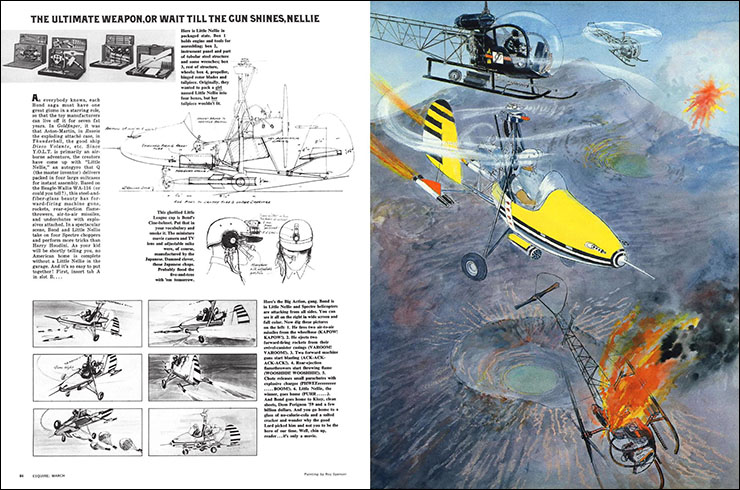 |
|
With the return of James
Bond to the big screen in 1995 after a six year hiatus, Esquire
featured Pierce Brosnan on the cover of the November issue, and an
extensive interview with the new 007 inside. Profiles of the two new Bond
Girls Famke Janssen and
Izabella Scorupco; and a new
post-modern James Bond short story ‘License to Hug’ by English author &
journalist Will Self, with illustrations by Mark Zingarelli. Although
mentioning Ian Fleming's creation by name, this was an unlicensed story
and never acknowledged as an ‘official’ piece of James Bond fiction. An
amusing secret agent quiz rounded off Esquire's substantial
coverage of GoldenEye (1995). Pierce Brosnan made the cover of
Esquire for a second time in November 2002 to coincide with the
release of Die Another Day. Although there was no content directly
related to his fourth (and final) James Bond film, Esquire printed
‘007 Interesting Things About Pierce Brosnan’ and a generic James Bond
quiz. By now the magazine was more interested in the actor's lifestyle and
what he wore, rather than directly promoting Pierce Brosnan's latest film.
|
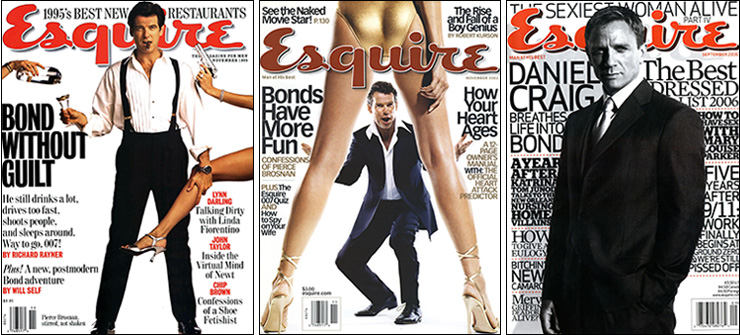 |
|
Daniel Craig was featured
on the cover of the September 2006 issue of Esquire, and like his
predecessor was introduced to American readers in an article the magazine
promised would give him a warmer welcome than the one he received back
home! As Esquire was predominantly a men's lifestyle magazine,
Craig also appears in several moody photographs dressed in expensive
designer outfits from the likes of Ralph Lauren, Hugo Boss
and Dolce & Gabbana. |
 |
|
|
|
|
|
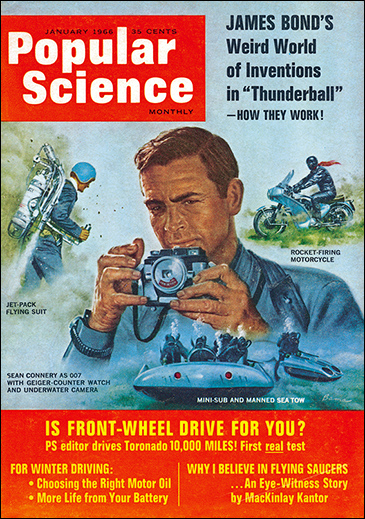 |
Thunderball
made the cover of the January 1966 issue of Popular Science,
this time with the focus strictly on the gadgets featured in the film.
A five-page article accompanied by black & white stills of the
various gadgets and technology featured in Thunderball (1965)
appeared inside. Founded in 1872, Popular Science was a
specialist monthly magazine that originally showcased science and
technology subjects for more educated readers, but evolved into a
publication that reported on science for a general audience.
The June 1967 issue
had a five-page feature on James Bond's amazing
WA-116 autogyro ‘Little
Nellie’ and an interview with its inventor
Wing Commander Ken Wallis
(1916-2013), accompanied by photos and an exclusive cut-away diagram.
Both issues of Popular Science had superb illustrated colour
covers by renowned American artist
James Bama
(1926-2022), who would later provide artwork for the 1967 paperback Alias James Bond - The Life of Ian Fleming
by John Pearson, and six
Ian Fleming James Bond novels from 1969-1972, all published by Bantam
Books.
The June 1967 issue
of Popular Science was also cross-promoted with a special
poster (30" X 40") supplied to cinemas by the National Screen Service
as they had for the two Esquire issues in 1965 and 1967.
Curiously, the
Popular Science poster was not advertised in the
United Artists
Pressbook for You Only Live Twice (1967), although the
Esquire poster was. |
|
 |
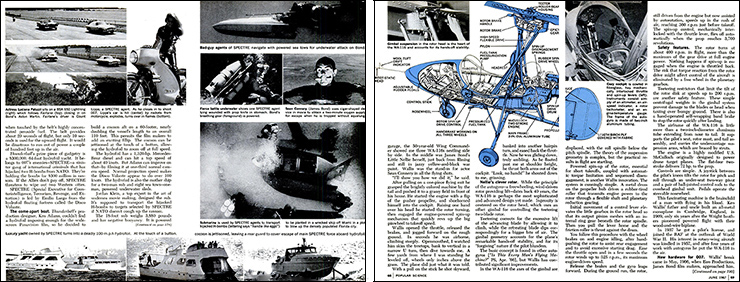 |
|
 |
|
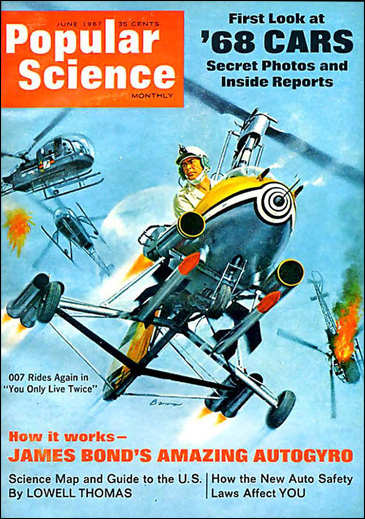 |
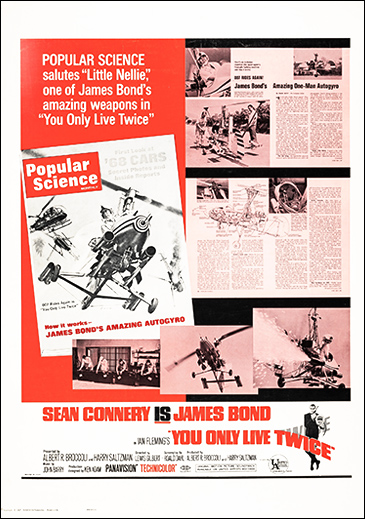 |
|
|
|
|
 |
& |
 |
|
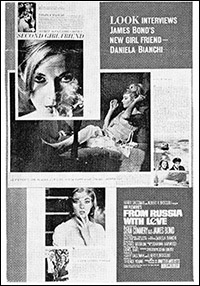 |
Daniela Bianchi was the
focus of a four-page feature titled ‘Secret Agent James Bond's Second Girl
Friend’ in the December 31, 1963 issue of LOOK - a bi-weekly
general interest magazine published from 1937-1971. The feature included
an interview with the Italian actress accompanied by film stills, and a
photo of her with Ian Fleming taken by
David Hurn when the author visited the location
filming of From Russia With Love
(1963) in Istanbul. The final issue of 1963 was published in memory of
John F. Kennedy and featured several article relating to the late
President, including a Christmas message written by Jackie Kennedy prior
to the assassination of her husband. The National Screen Service produced
a 10" X 8" black & white publicity still [pictured left] that was available during the
US release of From Russia With Love in April 1964. Sean Connery and Claudine
Auger were then featured on the cover of the July 13, 1965 issue of LOOK. The
magazine gave readers an eight-page preview of
Thunderball (1965) a full five months
before it was released in US cinemas. The feature was accompanied by
exclusive colour photographs by
Phillip Harrington (1920-2009). Before beginning his career in feature
films, Stanley Kubrick (1928-1999) was a staff photographer for LOOK,
and undertook over 300 assignments for the magazine between 1946 and 1951. |
|
|
|
|
Sean
Connery would again make the cover of The Saturday Evening Post
on July 17, 1965 which included a six-page background article on the
making of Thunderball accompanied by black & white photographs.
The Saturday Evening Post was first published in 1897 as a
weekly magazine up until 1963, then every two weeks until 1969. At its
height The Saturday Evening Post was one of the most widely
circulated and influential magazines within the American middle class,
with fiction, non-fiction, cartoons and features that reached two million
homes every week. |
|
|
|
|
|
|
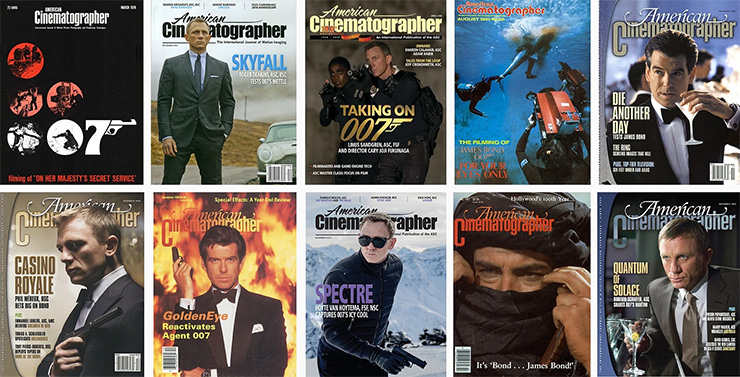 |
|
From 1970, in-depth articles
on the
making of the James Bond films have appeared in the specialist magazine American
Cinematographer. In addition to their extensive behind-the-scenes
coverage, eleven of the EON Productions films were featured on the cover
of the American
Society of Cinematographers’ monthly magazine. Never Say
Never Again (1983) also made the cover of the October 1983 issue,
which had a 12-page article on the underwater filming for Sean Connery's
comeback film as James Bond 007. |
|










